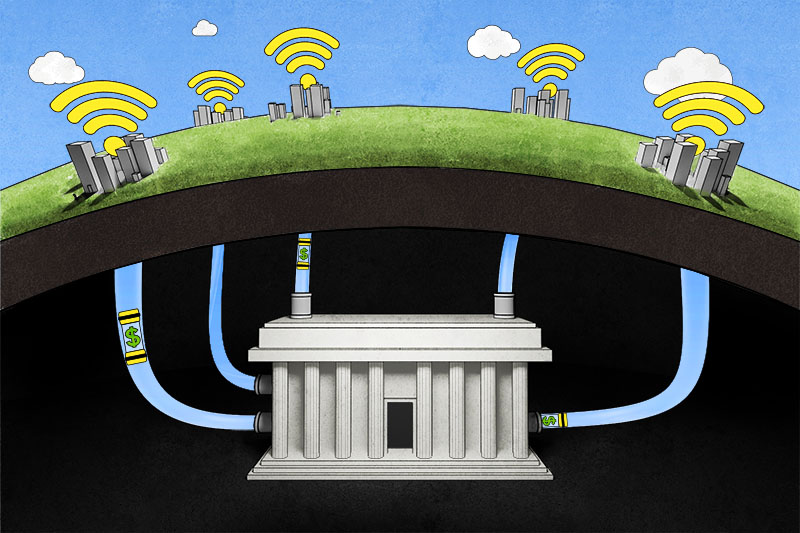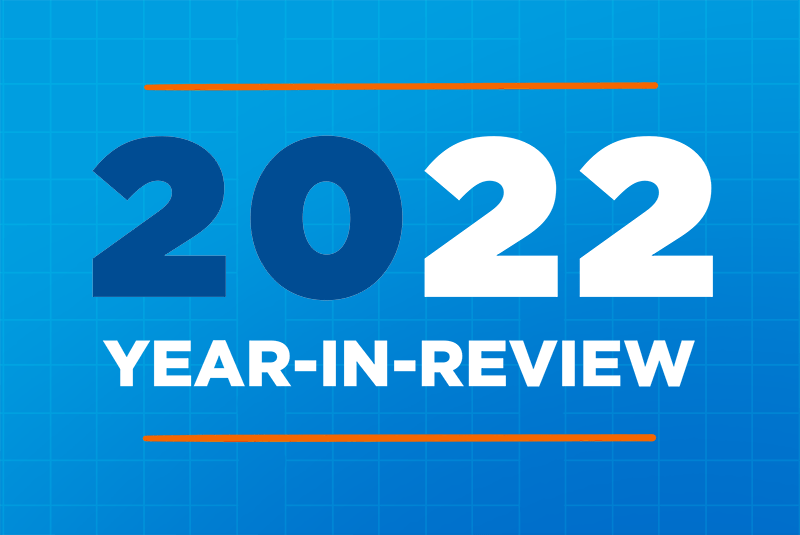It was a busy year. Rockefeller Institute researchers highlighted ongoing imbalances in how much money states give and get from the federal government and how COVID-19 radically shifted that balance. Our researchers analyzed the sluggish federal regulatory response to PFAS contamination, explored what remote work during COVID-19 could tell us about the future of work, proposed a new way of defining and understanding the nation’s care workforce, and equipped school leaders and stakeholders with data for understanding the threat posed by gun violence in schools and evidence-based strategies for keeping students safe.
Getting policymakers, practitioners, researchers, and advocates in the same room (or on the same Zoom) to connect on policy issues is a priority for the Institute. Solutions that emerge in these contexts are more robust, more equitable, and more resilient. Our annual Local Government Lab brought that method to bear on issues in local governance, highlighting the challenges facing our governments closest to the day-to-day lives of ordinary Americans (p.s. we are currently accepting proposals for the 2023 Local Government Lab). We doubled down on our local government focus with the Locally Sourced—Municipal Green Policy Solutions conference, co-hosted with SUNY ESF, which brought attention to the many ways local governments are thinking globally, implementing policy to mitigate negative climate impacts of human activity.
Preparing students for the professional policy environment is essential for ensuring future governmental effectiveness. Our Center for Law & Policy Solutions (CLPS) program, moving into its fourth year, continues to give undergraduate students hands-on exposure to policy analysis, advocacy, research, and the politics of law and policymaking. This year’s cohorts examined how to add resilience to our built environments through green infrastructure and state-level universal pre-kindergarten programs. The Future Leaders in Policy (FLIP) Competition offered another avenue for SUNY students to polish their policy chops by preparing a presentation to deliver to a panel of judges made up of New York State leaders and experts. Binghamton University’s Tanya McGee followed up her winning presentation with a blog on advancing equity in our built environment through planning tools like her proposed Neighborhood Equity Impact Assessment.
If you listened to Policy Outsider this year, you’d have heard outgoing NYS Budget Director Robert Mujica and NYC Budget Director Jacques Jiha as part of our Behind the Fiscal Curtain series. You might have also heard us speaking with researchers, practitioners, and policymakers across a diverse set of issues: child investment accounts, innovative uses for roadside right-of-ways, crypto mining, broadband, marriage equality, caring for veterans, Taylor Swift (i.e., predatory ticketing practices), and advanced manufacturing.
To finish up our year-in-review, we invited Rockefeller Institute staff to write about their favorite pieces from the year. Read what they had to say!

Defining the Care Economy
Laura Schultz, executive director of research
Over the past two years, I have struggled to find people to help me care for my child and relatives facing health crises. Aftercare programs across the country were unable to open the first weeks of school because of staffing shortages. I have received texts from friends looking for leads for someone to care for their babies. Arranging home health aides and visiting care providers for family members is a frustrating experience fraught with waitlists and last minute cancellations. Stories in the media confirm that my friends, family, and I are not alone in this struggle.
Policymakers working to develop solutions to labor shortages in these critical sectors need evidence to make effective policy. This is why Leigh Wedenoja’s report on Defining the Care Workforce is so important. The report takes an innovative approach. Instead of looking at sector-level trends, she explores the jobs that make up the care economy and the people who fill them. Care workers are overwhelmingly women (79%) and people of color (40% in NY). We see a big divide in the annual pay associated with these jobs. Well-educated and credential healthcare practitioners earn, on average, $86,000; workers in support positions, like home health aides and childcare, earn less than $33,000.
The number of these care economy jobs are expected to grow by 10.5 percent over the next decade, double the national average. Our aging population will need 815,700 new home health care aides alone. If we are going to meet this need, we need to rethink the barriers faced by women taking these positions, the opportunities they are pursuing instead, and what we can do to make this critical work more attractive. I look forward to the Institute continuing this important conversation in the new year.

Consolidating Fire Protection Services
Heather Trela, director of operations and fellow
Prior to 2022, my knowledge of fire districts was limited to a vague idea that they existed. That changed, however, after I read Rockefeller Institute Fellow Lisa Parshall’s excellent The Consolidation of Fire Protection Services in New York State: A Primer. The report is in fact a primer, providing an in-depth yet concise overview of the different ways that fire protection services are provided in New York and how municipalities configure the jurisdictions to provide said services. Parshall then makes the argument for fire district consolidation, given the decrease in the number of structural fires and a movement toward shared services between municipalities to save costs, and what New York State has done to encourage consolidations. The report concludes by exploring why, despite factors conducive to consolidation, it is still a relatively rare occurrence. A follow up piece does a deep dive on fire district elections which are often overlooked and have low participation due to their off-cycle timing in December, despite the budgetary and personnel issues at stake on the ballot. As a whole, Parshall’s pieces are a fascinating look at a local governmental entity that often receives little attention despite the critical services they provide.

Innovative Uses for Roadside Right-of-Ways
Brian Backstrom, director of education policy studies
Kaitlin Stack Whitney, a 2021-22 Nathan Fellow at the Rockefeller Institute of Government, used her fellowship to investigate and track innovative uses of roadway right-of-ways (ROWs). Estimated to total more land area than nine US states, the green space on the sides of the nation’s highways offer an exciting opportunity to impact everything from green energy supply to conservation of threatened wildlife species. In an article and a podcast, Stack Whitney dives deeper into the use of roadway ROWs for solar energy arrays (as at least six states do), agricultural crops (10 states), and pollinator-friendly field plantings (44 states). In the face of decreasing public funding, many states that are required to maintain these roadsides are exploring creative and even revenue-generating uses for these often-ignored resources. Installing solar energy arrays on ROWs can help states meet green energy targets, pollinator fields can help support the 80 percent of crops worldwide that need pollination while stimulating the conservation of important species such as monarch butterflies, and allowing haying or leaving crops standing through winter can benefit users of both the roadway and the roadside.
Maintaining road safety must always remain the number one priority, and challenges to creatively using ROWs stretch from funding to forming needed partnership. But the opportunity to study effective and innovative options for ROWs is growing right along with the interest by policymakers to use this largely untapped resource. Stack Whitney’s work helps explore these options and opportunities.
Behind the Fiscal Curtain
Leigh Wedenoja, senior policy analyst
As 2022 comes to a close New York State finds itself in a somewhat different budget position than it did last year. The lingering effects of the pandemic and uncertainty over inflation, Federal Reserve policy, and tax revenue are likely to affect next year’s budget negotiations. This is not the first time that New York State has confronted an uncertain and difficult budget process as highlighted by the Institute’s “Behind the Fiscal Curtain” series of podcasts, events, and blogs which discusses in depth the fiscal challenges New York has faced in the past.
The series begins with a discussion between Rockefeller Institute President (and former NYS budget director) Bob Megna and podcast host Alex Morse on the basics of the New York State budget, its timeline, and who is involved, and then continues with a series of discussions and events focused on very different budget challenges. Policy Outsider episode 45 focused on the (at the time) ongoing budget negotiations of February 2022 and brought on NYS Budget Director Robert Mujica to discuss the process and current concerns. Bob Megna sat down with former Governor David Patterson to discuss the impact of the great recession on the budget process and lessons for the future. The Behind the Fiscal Curtain Series also included a component focused on New York City, bringing together a panel discussion of the NYC fiscal crisis of the 1970s and a podcast discussion of the fiscal challenges faced during the pandemic with NYC Budget Director Jacques Jiha.
As we move in to 2023 and enter budget season, the series provides a valuable primer on the New York State budget process. And if you want to rewind, episode 48 of Policy Outsider provided an overview of the enacted budget and put in context the investments made in education, local government, the environment, and more.

Relieving the Burden Student Loan Debt
Laura Rabinow, deputy director of research
Director of Education Policy Studies Brian Backstrom’s policy brief, “States Step In: Relieving the Burden of Student Loan Debt” was one of my favorites this year because of the practical and immediate assistance it offered, in addition to its broader policy analysis. As Backstrom notes, there is “nearly $1.8 trillion in total outstanding debt nationwide.” In the brief, Backstrom outlines the long list of existing federal and state student debt relief programs that already offer some relief for borrowers and their families—particularly with respect to the various public service and targeted professions loan forgiveness programs at the state and federal level. Bringing these programs together in one place provides the kind of resource I wish I had as an undergraduate student as I made significant decisions about my own financial and professional future.
Shortly after the piece was published, the Biden administration announced its plan in August 2022 to forgive up to $10,000 of federal student loan debt for those under the income cap of $125,000 or up to $20,000 for recipients of Pell Grants. The Supreme Court has since agreed to take up not one, but two cases challenging the Administration’s policy, effectively putting the program on hold. In the meantime, the pause on payments for federal loans that began under COVID-19 has been extended for borrowers until 60 days following the end of litigation, implementation of the policy, or June 30th of 2023, whichever comes first. Even if the Biden Administration’s debt relief policy is implemented, it will not alone solve the issue of student loan debt for the tens of millions of people in America that already hold it, and the millions of incoming students that take on further loans to finance their education each year—though it will take a meaningful step towards addressing the problem for current borrowers.

Expanding Broadband Access and Adoption
Alexander Morse, associate director of public policy and government strategy
Kevin Schwartzbach, a graduate research assistant with the Rockefeller Institute, examined investments in building and promoting broadband infrastructure across the country and the importance of digital literacy for economic mobility, health, and education. Despite billions in public and private investment and broadband’s importance to modern day life, there are still significant barriers to universal adoption, including availability, costs, and a lack of digital awareness and literacy.
One interesting and persistent challenge noted by Kevin is the divide between broadband availability and adoption. Despite broadband being physically available to 95 percent of the public, only 69 percent of these customers have adopted broadband. Reasons for the divide between availability and adoption include affordability (the average price for home internet ranges between $50 and $150 a month) and a lack of digital skills and awareness. This digital divide can have significant adverse impacts on potential earnings, as people with a home internet connection and digital skills tend to have higher pay and greater opportunity for advancement.
Knowing the impact broadband can have on economic development, the federal government is investing $65 billion into broadband as part of the Infrastructure Investment and Jobs Act and encouraging states to develop programs to increase broadband adoption. An innovative model to provide internet to consumers at the local level is municipal and cooperative broadband, which are, respectively, publicly owned and non-profit alternatives to private internet service providers (ISP). There are nearly 1,000 communities that are currently served by a municipal or cooperative network. These public models face some opposition; at least 17 states have legislative restrictions blocking a municipality from providing internet to its constituents, citing inefficiencies and costs.
Kevin does a great job summarizing the nuances surrounding broadband investment and the different policy problems between broadband access and broadband adoption on Policy Outsider. On the episode, “A Lot of People Still Don’t Have Broadband. Why?” Kevin explains the importance of having a reliable internet connection, the hurdles to universal broadband adoption, and what policies different levels of government can employ to ensure everyone has access to, and adopts, affordable and reliable internet.

